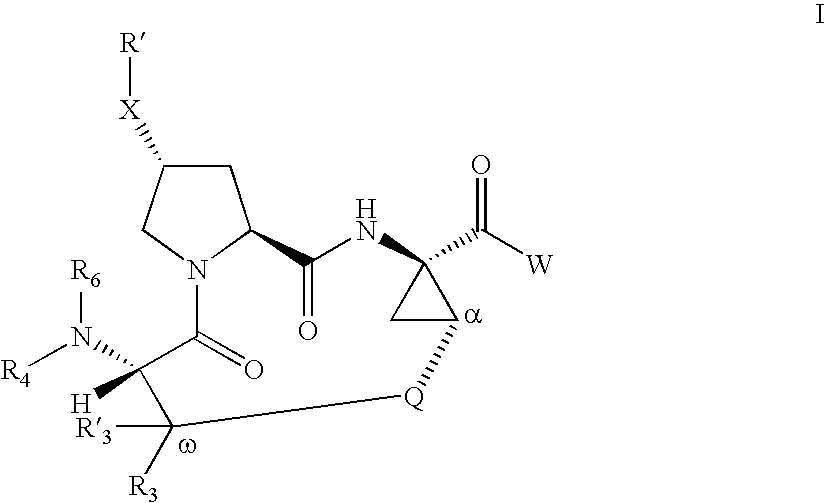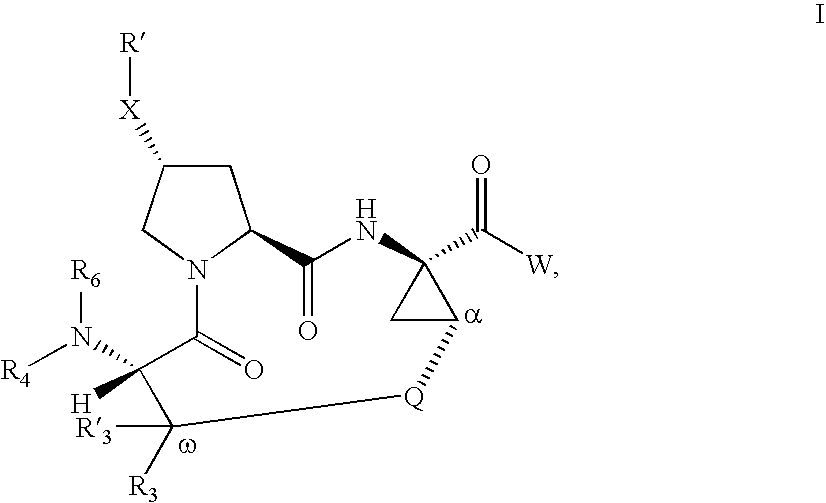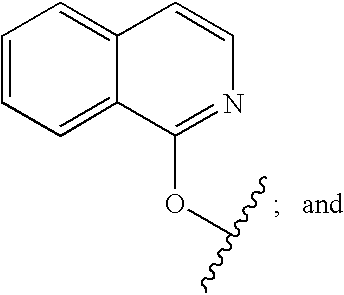Inhibitors of Hepatitis C Virus
a technology of hepatitis c virus and inhibitors, which is applied in the direction of peptides/proteins, drug compositions, peptides, etc., can solve the problem that a large percentage of patients do not have a sustained reduction in viral load
- Summary
- Abstract
- Description
- Claims
- Application Information
AI Technical Summary
Benefits of technology
Problems solved by technology
Method used
Image
Examples
example 1
Preparation of racemic (1R,2S) / (1S,2R)-1-amino-2-vinylcyclopropane carboxylic acid ethyl ester hydrochloride (Method A and Method B)
[0130]
[0131] The named compound was made racemic by each of the following methods A and B.
Method A
Preparation of N-Benzyl Imine of Glycine Ethyl Ester
[0132]
[0133] Glycine ethyl ester hydrochloride (303.8 g, 2.16 mole) was suspended in tert-butylmethyl ether (1.6 L). Benzaldehyde (231 g, 2.16 mole) and anhydrous sodium sulfate (154.6 g, 1.09 mole) were added and the mixture cooled to 0° C. using an ice-water bath. Triethylamine (455 mL, 3.26 mole) was added dropwise over 30 min and the mixture stirred for 48 h at rt. The reaction was then quenched by addition of ice-cold water (1 L) and the organic layer was separated. The aqueous phase was extracted with tert-butylmethyl ether (0.5 L) and the combined organic phases washed with a mixture of saturated aqueous NaHCO3 (1 L) and brine (1 L). The solution was dried over MgSO4, concentrated in vacuo to af...
example 2
Resolution of N-Boc-(1R,2S) / (1S2R)-1-amino-2-vinylcyclopropane carboxylic acid ethyl ester
[0140]
[0141] Resolution A
[0142] To an aqueous solution of sodium phosphate buffer (0.1 M, 4.25 liter (“L”), pH 8) housed in a 12 Liter jacked reactor, maintained at 39° C., and stirred at 300 rpm was added 511 grams of Alcalase 2.4 L (about 425 mL) (Novozymes North America Inc.). When the temperature of the mixture reached 39° C., the pH was adjusted to 8.0 by the addition of a 50% NaOH in water. A solution of the racemic N-Boc-(1R,2S) / (1S,2R)-1-amino-2-vinylcyclopropane carboxylic acid ethyl ester (85 g) in 850 mL of DMSO was then added over a period of 40 min. The reaction temperature was then maintained at 40° C. for 24.5 h during which time the pH of the mixture was adjusted to 8.0 at the 1.5 h and 19.5 h time points using 50% NaOH in water. After 24.5 h, the enantio-excess of the ester was determined to be 97.2%, and the reaction was cooled to room temperature (26° C.) and stirred overni...
example 3
Step 1: Preparation of ethyl 1(R)-amino-2(S)-vinylcyclopropane carboxylate hydrochloride
[0174]
[0175] Ethyl 1(R)-tert-butoxycarbonylamino-2(S)-vinylcyclopropanecarboxylate (8.5 g, 33.3 mmol) was stirred under an N2 atmosphere with 200 mL of 4N HCl / dioxane (Aldrich) at rt for 3 h. The solvent was removed under reduced pressure keeping the temperature below 40° C. This gave 6.57 g (˜100%) of ethyl 1(R)-amino-2(S)-vinylcyclopropanecarboxylate hydrochloride as a light tan solid. 1H NMR (300 MHz, CD3OD) δ 1.31 (t, J=7.0 Hz, 3H), 1.69-1.82 (m, 2H), 2.38 (q, J=8.8 Hz, 1H), 4.29 (q, J=7.0 Hz, 2H), 5.22 (d, J=10.3 Hz, 1H), 5.40 (d, J=17.2 Hz, 1H), 5.69-5.81 (m, 1H). MS m / z 156 (M++1).
Step 2: Preparation of ethyl 1(R)-[1-tert-butoxycarbonyl-4(R)-hydroxypyrrolidine-2(S)-carboxamido]-2(S)-vinylcyclopropanecarboxylate
[0176]
[0177] A stirred slurry of Boc-L-4-hydroxyproline (N-Boc (2S,4R)-hydroxyproline) (10 g, 43.3 mmol) in 400 mL of methylene chloride was treated sequentially with N-methyl mor...
PUM
| Property | Measurement | Unit |
|---|---|---|
| Current | aaaaa | aaaaa |
| Digital information | aaaaa | aaaaa |
| Volume | aaaaa | aaaaa |
Abstract
Description
Claims
Application Information
 Login to View More
Login to View More - R&D
- Intellectual Property
- Life Sciences
- Materials
- Tech Scout
- Unparalleled Data Quality
- Higher Quality Content
- 60% Fewer Hallucinations
Browse by: Latest US Patents, China's latest patents, Technical Efficacy Thesaurus, Application Domain, Technology Topic, Popular Technical Reports.
© 2025 PatSnap. All rights reserved.Legal|Privacy policy|Modern Slavery Act Transparency Statement|Sitemap|About US| Contact US: help@patsnap.com



